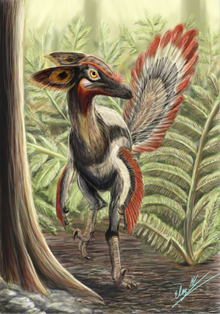Philovenator
| Philovenator | |
|---|---|

| |
| Life restoration. | |
| Scientific classification | |
| Domain: | Eukaryota |
| Kingdom: | Animalia |
| Phylum: | Chordata |
| Clade: | Dinosauria |
| Clade: | Saurischia |
| Clade: | Theropoda |
| Family: | †Troodontidae |
| Subfamily: | †Troodontinae |
| Genus: | †Philovenator Xu et al., 2012 |
| Species: | †P. curriei
|
| Binomial name | |
| †Philovenator curriei Xu et al., 2012
| |
Philovenator (literally meaning "love hunter") is an
Phillip J. Currie
.
Description
Philovenator is a
hands, and some of the highest non-avian encephalization quotients, meaning they were behaviourally advanced and had keen senses.[1]
Several distinguishing traits were established in the initial description. The thighbone possesses a distinctive process at the inner side of the lower end. The shinbone has on the upper front side a plate-like cnemial crest, protruding far to the front. The condyles of the astragalus and calcaneum are wide, measured from the front to the rear, and are separated by a deep and narrow groove. The
metatarsal at its underside, if the bone is held in a horizontal position, has a flange along most of the shaft length, being almost as wide as the remainder of the shaft.[2]
History of discovery
Philovenator is known from a single left hindlimb, first discovered in 1988 by the
autapomorphies of Saurornithoides, but based on the then current knowledge of anatomy and genera, the assignment was reasonable. In 2011, Linhevenator was described, and IVPP V 10597 was shown to have many similarities to this new taxon, possibly being a juvenile. However, a 2012 study of the histology and osteology of IVPP V 10597 determined that it was a new taxon related to Linhevenator, and it was named Philovenator curriei by Xu Xing e.a.. The name is derived from "Phil" and "currie", for Philip J. Currie, as well as the Greek φιλειν (philein), "to love", and Latin venator, or "hunter", suggesting it loved hunting.[2]
Classification
The
troodontid, closely related to other Late Cretaceous troodontids, such as Saurornithoides and Zanabazar from Mongolia, and Troodon from North America. The cladogram
below shows the phylogenetic position of Philovenator among the Troodontidae following this analysis.
| Paraves |
| ||||||||||||||||||||||||||||||||||||||||||||||||||||||||||||||||||||||||||||||
References
- .
- ^ a b Xu Xing; Zhao Ji; Corwin Sullivan; Tan Qing-Wei; Martin Sander; Ma Qing-Yu (2012). "The taxonomy of the troodontid IVPP V 10597 reconsidered" (PDF). Vertebrata PalAsiatica. 50 (2): 140–150.
- PMID 23028847.
